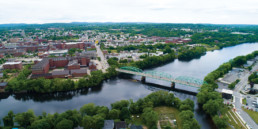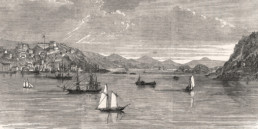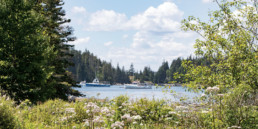The ‘Undeclared War’ on the Reviled Cormorant
Research dispels myths about their threat to sea life
By Dana Wilde
One summer morning in about 1963, I was fooling around in my 14-foot flat-bottomed punt near the beach on Mackerel Cove. Probably I was wrestling as usual with the oversized 15-horse Johnson outboard that was attached with clamps, twine, and hope to the punt’s frail transom, I can’t remember exactly.
The water was flat calm, so smooth and dark you might be able to walk on it. The sun was not yet high enough to be beating down, just illuminating the sea-fragrant, breathless island air. Boats motionless on their moorings. Distant clattering of lobster cars being handled. Birds, a few gulls floating serenely, obliviously nearby.
The rasp of an outboard approached. A fisherman in worn yellow slicker overalls, standing in the stern of his maybe 16-foot boat holding the outboard tiller-throttle angle-up, was cutting mathematically smooth waves through the water, coming in my direction.
I revered the lobstermen. This guy was strapping big, maybe 30 years old, an ancient mariner to ten-year-old me.
Fifteen or 20 feet from where I was floating, he cut his boat hard to starboard, throwing waves in my direction. But this was not about me. The cut ran him up beside one of the gulls, surprising it. Suddenly producing a bait pick in his other gloved hand, he stabbed down hard three or four times as he glided past. I saw the gull go head down in the water under the blows. Feathers and blood flew up. The fisherman accelerated away back up cove.
It was a long time before I had any idea what this violence might be about.
It was illegal to kill seagulls, as we colloquially referred to the great black-backed and herring gulls common along Maine’s coast. I knew that at age ten.
Much later I learned it was the federal Migratory Bird Act of 1918 that protected them. It was enacted because conservationists were already, more than a century ago, gravely concerned about human effects on wild bird populations. Great auks and passenger pigeons had been hunted to extinction, largely for fun. Gulls themselves were almost wiped out along the Atlantic coast by the late 19th century.
To me gulls seemed like dolts of the islands—ungainly and sour-looking perched, lurking stalkers in flight. They were known thieves (in the summer of 2019 a gull was videoed snatching a lobster roll from a tourist’s hand at an eatery near Nubble Light), and this was one reason some fishermen disliked them.
This fisherman impulsively (apparently) killing one gull would do nothing to reduce the competition for whatever fish or shellfish he thought gulls were stealing from his livelihood. So I kind of think it went deeper than that. Generationally deeper, maybe. I learned later that there were birds some people did not just dislike, but actively wished exterminated.
Cormorants, to be precise.
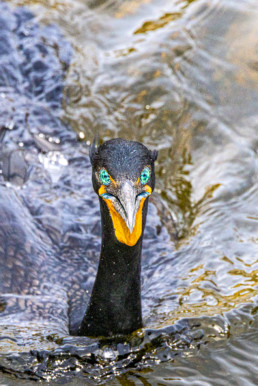
PHOTO:MICHAEL GIGLIA
These are the dark-colored low-riders of the water the fishermen call shag. They arrow in straight lines close to the surface, sometimes in formation, and dive like missiles for fish, going as deep as 60 feet or more. Their feathers do not shed water the way most birds’ do, and so cormorants are often seen perched on a buoy or an outcrop of rock with wings spread to dry.
Cormorant species live near water practically everywhere in the world. In the Gulf of Maine two are common, or have been—the double-crested cormorant (Nannopterum auritum) and the great cormorant (Phalacrocorax carbo). The double-crested cormorant has an orange throat pouch; the great cormorant is larger and has a white neck patch.
Along the Maine coast in winter, double-crested cormorants migrate south, while great cormorants migrate in from north. Double-crested cormorant populations are doing well, after ups and downs in the 20th century, and they’re found near fresh and salt water over much of North America.
Great cormorants’ North American populations inhabit mainly the East Coast from the Carolinas to Maritime Canada and Greenland. Their numbers are stable overall. But while a recent Audubon Christmas count logged 11 in the Pemaquid area, steep declines have been noticed in Maine recently; breeding populations of great cormorants are on Maine’s threatened species list. What’s causing the decline is uncertain; one possibility is the swelling numbers of bald eagles, which prey on the young birds.
Cormorants nest in colonies on rocky ground or in treetops. One of the things people have against them is that their feces accumulating around nesting sites can kill trees and other vegetation and are thought to foul water. They eat basically whatever is readily available to catch, including crustaceans, insects, and amphibians, but mostly fish.
And this is where the friction arises. For hundreds of years at least, cormorants have been viewed as a threat to human fishing activities.
“Black water rats,” one old-timer in Owls Head remarked to Richard J. King, author of The Devil’s Cormorant: A Natural History. “Good for nothing but bait.”
The old-timer was voicing a disdain so old it had become superstitious: “See one cross your bow and a storm’s on the way.”
New England’s double-crested cormorants were targeted as early as colonial times. Thinking their fishing livelihood was at stake, settlers set about getting rid of them. King finds Massachusetts colonist William Wood complaining in 1634 that cormorants “destroy abundance of small fish.”
Killed copiously for food, feathers, and sport, by the early 1800s cormorants had been extirpated from the region. Then, amid turn of the century conservation efforts, they were nesting in Maine again by the mid-1920s. They continued to be viewed as a threat, and a kind of undeclared war ensued involving fishermen, governments, biologists, and the cormorants.
In the 1930s a young University of Maine wildlife biologist, Howard Mendall, decided to find out if he could sort out what was and wasn’t true in the cormorant lore. His mission included spending days and nights collecting data on Marblehead Island, a nesting site just south of Owls Head. His eventual monograph, The Home-life and Economic Status of the Double-crested Cormorant, concludes (as King points out): “the [cormorant] is fully deserving of our protection and … except in scattered, local instances, it is largely neutral if not actually beneficial in its relationship to man.”
But Mendall’s research did not quell age-old suspicion. In the 1940s and ’50s, systematic efforts to reduce cormorant populations were in motion. Methods included culling birds by shooting them with .22 rifles and by egg-oiling, in which vegetable oil is sprayed on eggs, causing asphyxiation and reducing hatching success. Between 1944 and 1953, 188,000 eggs were oiled along the New England coast.
It didn’t really work. Despite deliberate efforts to kill them and the harmful effects of pesticides such as DDT, breeding populations of double-crested cormorants persisted. From the 1970s through the 1990s, as the use of pesticides came under some measure of control and the 1972 amendment to the U.S.’s Migratory Bird Treaty with Mexico specifically protected double-crested cormorants, their numbers increased.
Meanwhile, harvestable fish species were declining noticeably by the mid-1960s. Birds were taking Atlantic salmon smolts in large numbers around restoration-project hatcheries. Cormorants took the brunt of the blame.
Studies were undertaken to determine whether and how double-crested cormorant populations should be managed to protect fisheries. In general the studies try to find out what the birds eat by analyzing the contents of their stomachs, regurgitations, and feces, as well as making direct observations of their fishing behaviors.
Many studies, such as one conducted by a University of Maine team in the mid-1990s, more or less corroborate Mendall’s finding that cormorants do not take large commercial fish in undue numbers, and that overall the birds probably do not harm wild fish populations, and may even benefit local marine ecosystems. They do damage vegetation.
So with no research showing definitively whether negative effects outweigh positive, or positive effects outweigh negative, efforts to suppress double-crested cormorant populations rolled on into the 21st century.
King reports hundreds of thousands of double-crested cormorants and their eggs were destroyed in the 2000s in North America. Eggs were oiled, hundreds of birds were shot annually. Non-lethal harassment programs to disrupt nesting were also used, involving scarecrows (not too effective), throwing stones, lasers, and firecrackers.
A study from the mid-2000s found harassment of cormorants at nesting sites on Narraguagus Bay did result in reducing the number of smolts lost from Atlantic salmon restoration projects in the area. Birds find the pickings easy around dams.
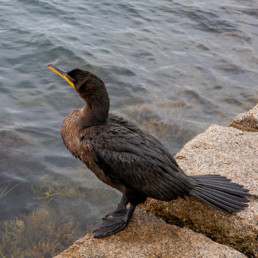
PHOTO: JACK SULLIVAN
Whether cormorants have any significant overall impact on harvests of wild fish is not clear. But the common wisdom, handed down for centuries, is that they do.
In Europe and North America, anyway. In parts of China and Japan, cormorants for centuries have been trained to catch fish, return to their human handlers, and regurgitate the fish whole, similar to the way falcons are trained. In those places cormorants are revered and using them to fish may have been brought from Asia to Europe around 500 years ago.
King James I’s enjoyment of cormorant fishing, though, seems to be an exception to an age-old prejudice. Milton in Paradise Lost describes Satan sitting on the Tree of Life “like a Cormorant … devising death / To them who lived” after sneaking into Eden. One of Shakespeare’s characters refers to the Trojan war in its voracity as “this cormorant war.” Chaucer speaks of the cormorant burning with gluttony.
Wildlife biologist Linda Wires traces what she calls the persecution of cormorants back to the biblical book of Isaiah. King observes in his book that even naturalists, disgruntled by damaged island vegetation, vilify cormorants and push for control measures. Some sportsmen have called for double-crested cormorants to be exterminated.
King tells the story of a group of sport fishermen on Lake Ontario in upstate New York organizing an activist group, Concerned Citizens for Cormorant Control. Convinced the cormorants were wrecking their sport fishing industry and fed up with complex regulations that already included studies, culling projects, and permits to shoot, they one summer night in 1998 gathered in boats, motored on the flat-calm lake to the cormorants’ nesting island, and slaughtered more than 20,000 birds, by their own count. They eventually were caught and fined, but long afterward remained unrepentant, according to King. They believed they were doing the right thing.
This is some deep-seated resentment, if not outright hatred. It rides the wake of centuries of learned prejudice. Whether the cormorants really have significant adverse effects on fish is almost as irrelevant as the research that disagrees about it. People learn to dislike cormorants, the feeling carries forward, accumulates over time, soaks into everyday life and lore, and becomes as hard to let go as superstition.
This is how prejudice works.
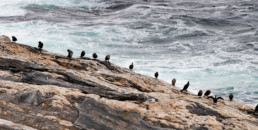
PHOTO: JACK SULLIVAN
I imagine the Bailey Island fisherman’s attack on the gull nearly 60 years ago was probably born of age-old, generational resentment. His father and grandfather, I’m thinking, may have disliked thieving gulls, like their fathers and grandfathers from the 19th and 18th centuries. He absorbed the common wisdom from back that far, the way we all absorb our moral values. His anchor was set. Gulls needed to be got rid of. So for the culling of black water rats, and everything else we learn early on to despise.
Not everyone detests cormorants, of course. When silent squadrons of two or three angle along with Doppler-like precision a few feet over the Penobscot River, they can take your breath away. When they stay down for what seems like impossible periods of time, pop up feet or yards from where they disappeared, they’re mysterious. Perched on a buoy, spreading their waterlogged wings to dry, they’re jesters. They still fish hereabouts, and they get in the way sometimes, no doubt. But they’re just making a living. Surviving, like the rest of us.
Dana Wilde is a nature columnist, book reviewer, former news editor, and college professor. His recent books are A Backyard Book of Spiders in Maine and Winter: Notes and Numina from the Maine Woods. He lives in Troy.


